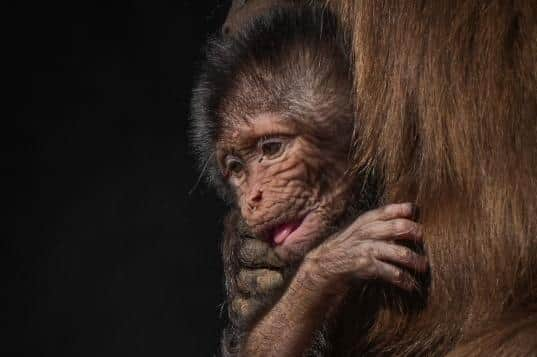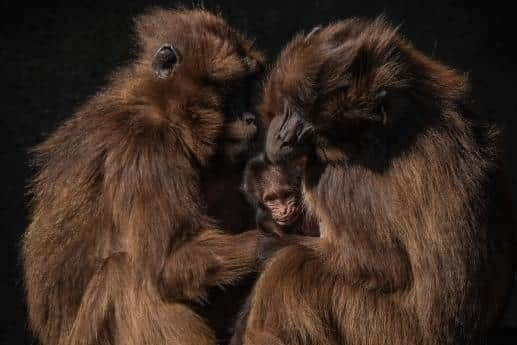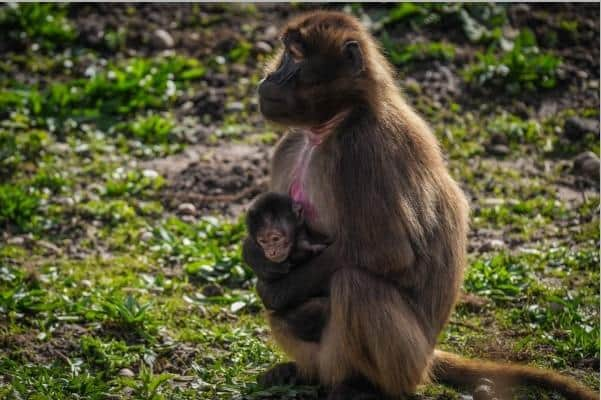Award-winning Yorkshire Wildlife Park is celebrating the birth of a cute Gelada Monkey
and live on Freeview channel 276
The adorable youngster, who is enjoying being carried around by mum, is already warming the hearts of visitors.
The baby boy was born on the 23rd March to mum Feven and dad Obi, a ground-breaking moment in the breeding of the species.
Advertisement
Hide AdAdvertisement
Hide AdThe public named the baby Gelada Kobo after a vote on social media. Kobo is a town near the Simien Mountains in Ethiopia, which is the only place Geladas are found in the wild, making it a perfect name for the park’s new arrival.


Feven and Obi welcomed the little one’s older brother, Azezo, back in December 2022 - the first Gelada to be born at Yorkshire Wildlife Park.
Greg Clifton, Section Manager (Primates and Carnivores), said: “It has been an extremely exciting time seeing the birth of our second Gelada Monkey here at the park and definitely a step in the right direction to preserving this incredible species.
“We have been working alongside the EAZA Gelada European Ex situ Programme (EEP) on a number research projects for years and moments like this it all truly pays off.
Advertisement
Hide AdAdvertisement
Hide Ad“As the youngster grows up it will be exploring the caves and foraging in our ‘Experience Ethiopia’ enclosure here at the park.


“Our multi-level society of Gelada’s at the Simien Mountain reserve now consists of 17 individuals. The 17 individuals are broken down into three harem's, Harry our original males group has become a lot smaller since arriving at YWP, consisting of two females and his four sons. In 2020 we welcomed two new males to join our troop Obi and Tayler, both males have matured now and have their own harem’s.
Taylor has acquired three females from Harrys group and Obi’s (our breeding male) group is made up of three females including his son Azezo and our new baby. The group currently display a social system similar to that seen in wild Gelada and is exciting to watch it develop.
“Now as we welcome another new baby, things may change again regarding the social structure within our three hareems. When female Geladas are looking for a male, they look for two things, protection, and potential fathers.
Advertisement
Hide AdAdvertisement
Hide Ad“Gelada monkeys are the last surviving species of grazing primates. They eat around a quarter of their body weight in grass every single day, making them a truly fascinating species!


“Gelada’s are native to the Ethiopian Highlands and have several unique adaptions, including their specialised stomachs which allow them to efficiently digest all that grass.
“We have been watching Feven closely for the last six months throughout her pregnancy. Females Geladas show their reproductive cycle on their chests unlike other species of primates, which may show their statuses through their bottoms.
“Throughout their pregnancy female Geladas get several chin rolls on the neck which get bigger in size. This is also a way of letting the males Geladas know they are pregnant.
Advertisement
Hide AdAdvertisement
Hide Ad“As part of our husbandry and care here at the park we record every female’s monthly cycle to help us work out who is pregnant in our groups. Watching these key signs closely is how we found out that Feven was pregnant. We could then monitor her progress.
Adult males can be easily spotted at the park by their handsome manes of long hair!
“It is very early days for the youngster, but we are looking forward to seeing the new baby grow within the group at the park and hopefully this is the beginning of many more successful births of Gelada babies!”
Yorkshire Wildlife Park works closely with the Wildlife Foundation, which is based at the park, to rescue and protect some of the world’s rarest and most endangered species of animal.
Advertisement
Hide AdAdvertisement
Hide AdThe 175-acre park offers visitors a unique walk-through experience bringing them almost face to face with some of the world’s most beautiful and at-risk species, including Black Rhinos, Tigers and the UK’s largest collection of Polar Bears.
Comment Guidelines
National World encourages reader discussion on our stories. User feedback, insights and back-and-forth exchanges add a rich layer of context to reporting. Please review our Community Guidelines before commenting.